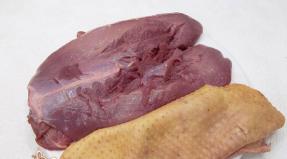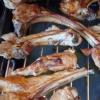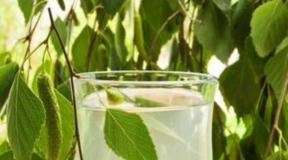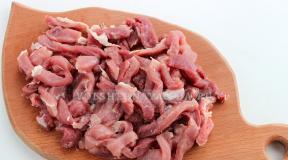Brief description of tea Ivan tea. medicinal plants
Ivan-tea narrow-leaved - Chamaenerion angustifolium (L.) Scop.
Cypress family - Onagraceae
(Folk names: fireweed, Ivan-tea, plakun, skrypnik, Koporsky tea, Kuril tea)
Description of Ivan tea
Perennial herbaceous plant 75-200 cm high with a high, straight, weakly branched stem. The leaves are alternate, lanceolate, with prominent veins, entire or with small teeth along the edges. The flowers are large, purple-red, collected in beautiful long brushes. The fruit is a long capsule. Blooms in late June - August.Location. Found in all areas.
Habitat. It grows in forests, among shrubs, on edges, embankments, along ditches and roads.
Used part. Stem, leaves. The sweet roots are edible.
collection time. June August.
Chemical composition. The roots and leaves contain from 10 to 20% tannins.
Ivan tea properties
Traders mixed the dried leaves of the plant into tea, hence the name of the plant willow-tea, Koporsky tea. In folk medicine, Ivan-tea is used as an anti-inflammatory, analgesic, for insomnia, headache; as a hemostatic agent for uterine bleeding. Outwardly, an infusion of herbs is used for washing wounds, ulcers, for rinsing with inflammation of the oral mucosa, sore throat; in the form of a compress - with inflammation of the ear, bruises, joint pain.Ways to use Ivan tea
1. Pour 1 tablespoon of herbs with 1 cup of boiling water, insist until cool, strain. Take 1 tablespoon 3 times a day before meals. The same infusion is used for external use.2. Hot compresses from steamed grass collected during the flowering period.
Source of material: Medicinal plants of the Central Chernozem region, 1973 / Zavrazhnov V.I., Kitaeva R.I., Khmelev K.F./
Synonym: narrow-leaved fireweed.
Perennial, fairly tall herbaceous plant. It is widely used in scientific and folk medicine for preventive and therapeutic purposes.
Ask the experts
flower formula
Ivan tea flower formula: Ch4L4T8 (4) P4.In medicine
An aqueous infusion of willow-herb leaves (fireweed) is used for headaches, metabolic disorders and stomach ulcers (the flowering tops are usually brewed and drunk as tea). Fresh crushed leaves, applied to wounds, contribute to their rapid healing. A decoction of the leaves is used for scrofula, gastric diseases and as a sleeping pill, for inflammation of the ear, throat and nose. The beneficial properties of fireweed tea are quite effective for prostate adenoma. An aqueous or alcoholic extract of fireweed prevents the inflammatory process and has a healing effect in acute and chronic diseases of the prostate, adenoma, inflammation of the ureters and chronic inflammation of the bladder, as well as a supportive and absolutely harmless therapy after prostate surgery.

In dermatology
In dermatology, Ivan-tea angustifolia is used for psoriasis, lichen planus, neurodermatitis, eczema, as an antipruritic and antispasmodic agent for allergic skin diseases, especially in children. Powdered willow-tea leaves are sprinkled on wounds and ulcers.
In cooking
Young shoots and leaves are eaten (for salads, soups, seasonings for meat dishes), as well as sweet rhizomes (raw and boiled; dried and roasted are used as a coffee surrogate). In the Caucasus, flour is made from them, bread is baked, and they are also used to make alcoholic beverages. Ivan-chai is a good honey plant. Dried leaves are used as a substitute for tea.
Classification
Ivan-tea narrow-leaved or narrow-leaved fireweed (lat. Chamaenerion angustifolium (L.) Scop., or Epilobium angustifolium L.) - is one of the most famous species of the family Cypress, or Oslinnikovye (lat. Onagraceae). Ivan-tea is a representative of the genus (lat. Chamerion), a species very widespread in temperate and subtropical regions. The generic name comes from the Greek. chamae - low (small) and nerion - the name of the subtropical oleander shrub (Nerium oleander L.). In everyday life, Ivan tea is usually called fireweed, although it is a separate genus (Epilobium), also belonging to the same family. However, the use of Ivan-tea leaves as a tea substitute, i.e. surrogate and determined its name.
Botanical description
Perennial rhizomatous fairly tall herbaceous plant 50-180 cm in height. It has a thick creeping rhizome up to 1 meter long, erect, cylindrical, slightly branched, densely leafy bare stems 50-150 cm high. The leaves are very numerous on one shoot, alternate, entire, sessile, lanceolate, 5-12 cm long, 0.7- 2 cm, with sharply protruding veins, dark green above, bluish-green below. The flowers are 4-membered, large (about 3 cm in diameter), slightly zygomorphic, bright pink or purple, purple, sometimes white with a deep four-parted calyx, with a short tube and an irregular corolla. The inflorescence is a terminal rare long raceme or spike, the flowers of which open from 6 to 7 in the morning. Perianth double. Ivan tea flower formula: Ch4L4T8 (4) P4. The calyx is joint-leaved, the corolla is separate-petal. The fruit is a long pod-shaped (up to 5-9 cm) capsule, consists of four valves, with numerous oblong-oval seeds, with a fluffy white tuft. Blooms from late July to mid-August, sometimes until September.
Spreading
It occurs almost throughout the European part of Russia. It grows among shrubs, in forests, especially abundantly light, in particular pine and birch, on edges, clearings, wastelands and dried peat bogs, embankments along ditches and on roadsides. Ivan-chai belongs to the so-called explerants, species quickly occupying areas free from vegetation. It is the first among other plants to cover forest fires and clearings with its flowers, forming continuous thickets over large areas. However, the territories occupied by it are not kept for a long time - they are inferior to other species. Prefers sandy soils, picky about light. Sometimes bred as an ornamental plant.
Distribution regions on the map of Russia.
Procurement of raw materials
For therapeutic purposes, fireweed grass, leaves and flowers are harvested during flowering, dried in the shade, under a canopy, in attics, open verandas, in well-ventilated areas, scattered in a thin layer on a clean bedding, or dried for 1 day, twisted with palms until it comes out juice, then laid out on a baking sheet, covered with a wet cloth, kept for 6-10 hours at a temperature of 25 ° C and dried for 40 minutes in an oven at a temperature of 100 ° C. Store raw materials in a dry, ventilated area, checking periodically. The roots are dug up in autumn, cleaned from the ground, dried in dryers, ovens, ovens at a temperature of 65-70 ° C. Store in a well-closed wooden container or glassware for 2 years. Shelf life of grass is 2 years, roots - 3 years.
Chemical composition
Fireweed leaves and roots contain a large amount of tannins (up to 20%), mucus (up to 15%), flavonoids, pectins, alkaloids, ascorbic acid (up to 338 mg%, three times more than in orange fruits), sugar, organic acids, mineral salts (iron 23 mg%, manganese 16 mg%, boron 6 mg%, copper 2.3 mg%, nickel and titanium 1.3 mg% each, molybdenum 0.44 mg%). The roots of the plant lack tannins and contain less mucus.
Pharmacological properties
Due to the content of tannins and mucus, fireweed leaves and roots have astringent, wound healing, anti-inflammatory and enveloping properties. Whole fireweed leaves have significantly less anti-inflammatory activity than crushed leaves. This phenomenon is observed in connection with the combined action of tannins and mucus. They also have a calming (sedative), anticonvulsant, analgesic effect. Fireweed preparations are low toxic.
Application in traditional medicine
In folk medicine, an infusion of fireweed herbs is taken for colitis, gastritis, peptic ulcer of the stomach and duodenum, headache, and insomnia. A decoction of fireweed leaves is recommended for gastritis, colitis, peptic ulcer of the stomach and duodenum, bleeding, anemia, acute respiratory diseases. Also used for gargling with sore throats, washing wounds, ulcers, bedsores. Fresh crushed leaves can be applied to festering, long non-healing wounds, ulcers, bedsores. Steamed flowering grass is used for compresses on painful places (joints, muscles, bones). Powder from the dried leaves is sprinkled on wounds, ulcers and frostbitten areas of the body. Also in folk medicine, fireweed is used for gonorrhea and syphilis. Healers used Ivan tea in the treatment of epilepsy, alcoholic psychosis, anemia, as an emollient and diaphoretic for colds, as well as in the treatment of various types of malignant tumors.
History reference
At first, in Russia, tea was a rather expensive drink, and it was sometimes faked in the village. Koporye, the former St. Petersburg province, earning a lot of money from this. At the same time, since the time of Catherine II, “Koporsky tea” has been made most of all from fireweed leaves. The leaves were doused with boiling water and twisted. Their infusion had a pleasant taste, but of course it was deprived of the qualities of real tea.
"Ivan-tea" is an ancient Russian name that has survived to this day. The legend says that the boy Ivan once lived. He liked to flaunt in a red shirt and spent most of his time among the flowers. Local residents, who saw a scarlet color flashing among the greenery, said: “Yes, this is Ivan, tea, he walks.” And they got used to it so much that they didn’t notice Ivan’s absence, and at the scarlet flowers that suddenly appeared near the outskirts of the village, they began to say: “Yes, this is Ivan-tea.” Since then, fireweed and a drink from it have been called Ivan-tea. Folk names of Ivan-tea: fireweed, plakun, skrypnik, Koporye tea, bread box, miller, dremukha, mother liquor and many others.
In the early 70s of the XX century, a group of Russian specialists at the All-Russian Cancer Center of the Russian Academy of Medical Sciences obtained the drug hanerol. The raw material for its production was Ivan-tea inflorescences, collected in the phase of mass flowering. It was found that Ivan-tea has a pronounced cytostatic and hemagglutinating activity, which is confirmed by experimental studies. Hanerol has antitumor activity. According to the spectrum of its activity, it is closer to the group of antimetabolites, which, for example, include the drug 5-fluorouracil. At the end of the 20th century, the laboratory for preliminary testing of antiviral substances of the Belarusian Research Institute of Epidemiology and Microbiology studied the antiviral activity of individual plant samples and herbal preparations growing in Belarus. The ability of fireweed angustifolia to suppress the reproduction of the herpes simplex virus in tissue cultures has been established.
Literature
1. Atlas of medicinal plants of the USSR / Ch. ed. N. V. Tsitsin. - M. 1962. 702 p.
2. Blinova K. F. et al. Botanical-pharmacognostic dictionary: Ref. allowance / Ed. K. F. Blinova, G. P. Yakovlev. - M.: Higher. school, 1990. - S. 187. - ISBN 5-06-000085-0.
3. State Pharmacopoeia of the USSR. Eleventh edition. Issue 1 (1987), issue 2 (1990).
4. State Register of Medicines. Moscow 2004.
5. Ilyina T.A. Medicinal Plants of Russia (Illustrated Encyclopedia). - M., "EKSMO" 2006.
6. Zamyatina N.G. Medicinal plants. Encyclopedia of the nature of Russia. M. 1998.
7. Medicinal plants: A reference guide. / N.I. Grinkevich, I.A. Balandina, V.A. Ermakova and others; Ed. N.I. Grinkevich - M .: Higher School, 1991. - 398 p.
8. Medicinal plants of the State Pharmacopoeia. Pharmacognosy. (Edited by I.A. Samylina, V.A. Severtsev). - M., "AMNI", 1999.
9. Medicinal plant materials. Pharmacognosy: Proc. allowance / Ed. G.P. Yakovlev and K.F. Pancake. - St. Petersburg: Spec. Lit, 2004. - 765 p.
10. Lesiovskaya E.E., Pastushenkov L.V. "Pharmacotherapy with the basics of herbal medicine." Tutorial. – M.: GEOTAR-MED, 2003.
11. Maznev V.I. Encyclopedia of Medicinal Plants -. M .: Martin. 2004. - 496 p.
12. Mannfried Palov. "Encyclopedia of Medicinal Plants". Ed. cand. biol. Sciences I.A. Gubanov. Moscow, Mir, 1998.
13. Mashkovsky M.D. "Medications". In 2 volumes - M., New Wave Publishing House LLC, 2000.
14. Novikov V. S., Gubanov I. A. Genus Spruce (Picea) // Popular atlas-determinant. Wild plants. - 5th ed., stereotype. - M.: Bustard, 2008. - S. 65-66. - 415 p. - (Popular atlas-identifier). - 5000 copies. - ISBN 978-5-358-05146-1. - UDC 58(084.4)
15. Nosov A.M. Medicinal plants in official and traditional medicine. M.: Eksmo Publishing House, 2005. - 800 p.
16. Peshkova G. I., Shreter A. I. Plants in home cosmetics and dermatology. Ref //M.: Ed. House of SMEs. - 2001. - 685 p.
17. Plants for us. Reference manual / Ed. G.P. Yakovleva, K.F. Pancake. - Publishing house "Educational book", 1996. - 654 p.
18. Plant resources of Russia: Wild flowering plants, their composition and biological activity. Edited by A.L. Budantsev. T.5. M.: Association of scientific publications KMK, 2013. - 312 p.
19. Sokolov S. Ya. Medicinal plants. - Alma-Ata: Medicine, 1991. - S. 118. - ISBN 5-615-00780-X.
20. Sokolov S.Ya., Zamotaev I.P. Handbook of medicinal plants (phytotherapy). – M.: VITA, 1993.
21. Turova A.D. "Medicinal plants of the USSR and their application". Moscow. 1974.
22. "Phytotherapy with the basics of clinical pharmacology", ed. V.G. Kukes. – M.: Medicine, 1999.
23. Chikov P.S. "Medicinal plants" M.: Medicine, 2002.
One of the most unusual, but at the same time useful plants on our planet is the narrow-leaved fireweed, which is popularly called Ivan-tea. Even in ancient times, people knew about its exceptional healing properties, but even today the herb is widely used to heal various ailments and to give strength and energy to the whole body.

Description and range
Drinking a fragrant drink from Ivan-tea began in the 12th century. Due to its availability, it was mainly consumed by the poor, however, representatives of the rich classes did not disdain a cup or two of delicious tea. In the 13th century, the monks of St. Petersburg began to grow Ivan tea, dry it and make it raw material for brewing. Reviews of this unique drink quickly reached Europe. Until the 19th century, this product occupied one of the first places in Russia's foreign trade, but after the Revolution it was undeservedly forgotten, and only recently they started talking about the drink again.


What does it look like and why is it called that?
Ivan-chai has a straightened stem of a rounded shape, its foliage is dense, the leaf plates are quite long, their size varies from 4 to 12 cm, the shape is pointed, lanceolate. The leaf blades are painted a rich dark green above, and the lower surface usually has a bluish tint, less often reddish and less often pink.
The flowers are large and reach 3-4 cm in diameter, painted in white-pink or purple-red. Quite rare, but, nevertheless, you can find plants with milky white flowering. Flowers gather together in inflorescences in the form of brushes, reaching a length of 40 cm. Flowering begins in the second half of summer and lasts about a month. The fruits look like small pod-shaped boxes, they ripen seeds that can be easily carried by wind and rain.



The legend associated with this beautiful flower is very interesting. They say that in one small village near St. Petersburg there lived just a guy Ivan, who constantly walked in a red shirt. He spent a lot of time in the forest and was known as a good herbalist. Local residents more than once caught him picking berries, herbs and healing roots, and every time they met the young man, they shouted "Ivan, tea, wanders."
One day the boy disappeared and no one knows how and why this happened, but immediately after his disappearance, on the outskirts of the village, unprecedented flowers of an amazingly beautiful bright scarlet color bloomed. People mistook them for a herbalist's shirt and out of habit said "Ivan, tea, wanders." Hence the name of the herb - Ivan-tea.


However, the plant has a lot of other names:
- "willow-grass"- because of the similarity of the leaves with the leaves of the weeping willow;
- "firefighter"- the flower received a similar name because it is the very first to appear on the ashes;
- "plakun"- with any attempt to pull a plant with a root out of the ground, it makes a creak that looks like a sob;
- "wild flax"- this name is explained by the good bast characteristics of the stems;
- "breadbasket"- the poor dried the grass, ground it and added it to flour, such an additive significantly saved, or even completely replaced sweet sugar;
- "down jacket"- when fireweed blooms, a large amount of fluff is released, which in ancient times was collected and filled with mattresses and pillows.


Where does it grow in Russia?
Ivan tea has a truly extensive habitat, it grows in the Central zone of Russia, and in addition, it can often be found in the Caucasus, as well as the Far East and Siberia. It is ubiquitous in areas with sandy loamy soil, in forest clearings, and even near railway tracks. It is this grass that grows first in the forests where the fire occurred, although as young trees and shrubs grow, the plantings thin out.
In most cases, he chooses the wet banks of small rivers and streams. This is due to the special moisture-loving fireweed, it is in such places that it grows as violently as possible.



Quite often, Ivan tea is found in forests, both coniferous and deciduous. At the same time, the seeds are carried by the wind over fairly long distances, which is why grass can be found anywhere, even in a suburban area away from wild meadows and forests. However, fireweed does not grow in swampy areas, the seeds do not fully ripen in conditions of strong shading.
When collecting Ivan tea, try to give preference to places remote from busy highways and the railway - such plants absorb all the harmful exhaust gases and can be hazardous to human health.


Varieties
Ivan tea has about 14 varieties, the most common are the following.
- narrow-leaved is a perennial herbaceous plant. Its height, as a rule, is 1-1.5 m, but sometimes it can even reach two meters. It has a dense strong root system, strong erect stems and abundant foliage. Leaf blades are rich green, darker above, fading to a bluish tint below. Flowering pink-purple, in rare cases white. A drink made from narrow-leaved willow-tea is characterized by powerful medicinal properties, therefore it is widely used in herbal medicine.

- broad-leaved distributed in the North and the Far East, has rather elongated leaves, the size of which reaches 10 cm, the shape is spear-shaped, the ends are narrowed. There may be hairs on the leaf plates. Dark pink flowers, racemes. The plant is very popular among the indigenous population, the Eskimos eat it raw, and also brew it like regular tea.

- Caucasian- lives in the lower reaches of the rivers in the Caucasus, as well as in the Stavropol Territory and Adygea. This is a small plant, the height of which does not exceed 50 cm, the size of the leaves is 1-3 cm, the inflorescences are pink, round, the flower brushes are shortened. This plant is mainly grown as an ornamental.

- Dodonei- reaches a meter height, characterized by single, slightly branched stems. The flowering is milky white or light pink, the leaves are even linear-lanceolate in shape, the edges of the leaf plates are without notches. Most often grows in the middle belt and subalpine belt.

- Steven- another undersized plant with bare and very narrow leaves, their width rarely exceeds 3 mm, leaf plates have hairs.

- Fletcher- perennial grass up to 45 cm high. The plant has rather powerful roots and dense stems with a large number of shoots, which are densely covered with leaves of a linear configuration with pointed ends. The length of the sheet reaches 4 mm. It blooms with rich bright pink flowers from June to August. It is resistant to low temperatures and is ubiquitous in our country and in European countries.

- Colchis- common in the Caucasian regions, where it grows at considerable heights, forming entire alpine meadows of incredible beauty. The plant is undersized, flowering is bright pink.


Low-growing plants are considered decorative, therefore they are widely used in landscape design. The narrow-leaved and, to a slightly lesser extent, broad-leaved Ivan-tea varieties give the greatest benefit.

What is in the herb?
Fireweed grows almost throughout the entire territory of our vast country, it is absolutely adapted to any weather conditions. Its ground part is collected from July to September (at the time of flowering), the root part is collected in spring or autumn. In flowers, as well as leaves, stems, roots, there are:
- tannin components- for the most part of the pyrrogal group, they have a strong astringent, antimicrobial and hemostatic effect;
- flavonoids- these are quartzetin and kaempferol, they have a diuretic and mild antispasmodic effect;
- vitamin C- helps to increase immunity, resistance to colds and fungal infections;
- mucous components– are characterized by the ability to envelop, relieve convulsions, inflammation and pain;
- alkaloids- are considered good analgesics and in small concentrations stimulate metabolism and normalize blood circulation;
- pectin– favorable for the organs of the digestive system;
- chlorophyll- exhibits a strong wound-healing effect, normalizes metabolic processes in the human body;
- polysaccharides- are an active participant in all immune processes;
- organic acids- necessary to maintain the balance of acids and alkalis in a normal state;
- mineral elements- manganese + iron, necessary to improve the quality of the blood, and nickel + molybdenum, which create the conditions for maintaining strong immunity.

Useful properties of narrow-leaved fireweed
Due to the presence of a huge amount of nutritional components, fireweed has a strong healing and immunostimulating effect. One of the most pronounced are antimicrobial and antispasmodic properties, due to which the herb is widely used for the treatment of enteritis, gastritis, and in addition, pathologies of the prostate and urinary system.
The plant has a sedative effect, helps to reduce nervous tension, improve the psycho-emotional state and improve sleep.
Drinking tea allows you to increase hemoglobin, restore electrolyte balance in the vessels and get rid of migraines.
Fireweed is very useful for the gastrointestinal tract and the normalization of metabolic processes, thanks to it you can forget about constipation, heartburn and such unpleasant problems as diarrhea and dysbacteriosis for a long time.
The plant is widely used to stop inflammatory processes and effectively prevent infectious diseases - with the systematic use of tea, pathological processes slow down and even stop. It should be noted that there is no such useful chemical composition even in oak bark.


Ivan tea is characterized by a powerful urinary and choleretic effect, it significantly improves water-salt metabolism, fights various viruses and allergy manifestations.
Herbal drink is extremely useful for new mothers when breastfeeding, as it has the ability to increase lactation. The result of including it in the diet of a nursing woman is to maintain the production of the right amount of breast milk, so that women get the opportunity to feed their children for as long as possible, which is extremely beneficial for newborn babies.
Fireweed is universally prescribed for a comprehensive cleansing of the body, it helps to remove all unnecessary toxins and toxins, and also regulates the functioning of endocrine organs.
Herbal tea has a pronounced anti-aging effect, helps slow down age-related changes, improves skin condition, makes it fresh, very radiant and smooth.


Ivan tea is necessary not only for the fairer sex, but also for men, since it can have a beneficial effect on prostate adenoma, and also normalizes potency and supports erectile function. As a result, men, even at a respectable age, retain the ability to have a sexual life and even conceive.
As for the fairer sex, fireweed is considered one of the most powerful means in the fight against cystitis, thrush and other diseases of the pelvic organs. This drink is also often consumed for weight loss.


Contraindications and harm to health
There are few contraindications to taking fireweed, but, nevertheless, they exist. Most importantly, it should be borne in mind that with constant continuous use of the drink for more than a month, there is a high risk of digestive dysfunction.
Herbal infusions are not advised to drink with varicose veins, as well as with thrombosis and thrombophlebitis.
Some pediatricians believe that tea should not be included in the diet of children under 2 years old, however, official medicine is well aware of cases when herbal decoctions helped even the smallest crumbs.
The list of contraindications also includes an allergic reaction and a sharp individual intolerance to the components of the herb.


Application rules
The scope of Ivan tea is wide and is by no means limited to brewing tea. Young green leaves are often used to prepare vitamin salads and soups - for this they just need to be cut without any preliminary heat treatment. However, this plant does not have a pronounced independent taste, like wild garlic, for example. However, in field conditions, grass is indispensable.
Leaves can also be added to first courses, young succulent parts of the plant are also used for this. The leaves can also be brewed into tea, but most often the flowers of the plant are used to make a drink, for this they are boiled in water for 5-7 minutes, after which they are either used as tea leaves or added to jelly with rhubarb or berries.
The proportions for making such tea are the same as for ordinary black tea - to make a cup of aromatic drink, take half a teaspoon of herbs and pour a glass of boiling water. If desired, you can add sage, oregano or mint. This combination significantly improves the taste and nutritional value of the infusion.


Ivan-tea is recommended to use up to 5-6 times a day, while tea leaves can be used up to 3 times by adding a little boiling water to it. The beneficial properties of such a drink are preserved, although the taste is slightly weakened.
The brewed drink can be stored for up to 3 days, after throwing out the grass.
Tea is drunk hot or cold, preferably without sugar. If desired, you can add honey, as well as drink it with halvah or dried fruits.


Features of growing a plant
Fireweed seeds are formed quite abundantly and are carried along with fluff by wind and rain, so it would be fair to assume that fireweed should grow everywhere, but this does not happen at all. The reason is that the grass is very demanding on light, and its seedlings are very weak and cannot tolerate the slightest competition from other weeds.
To enjoy the taste and healing properties of fireweed, some try to grow it on their own in their area. In this case, you should know that the plant will develop well in areas open to sunlight and in nutritious, mineral-filled soils. In addition, the plant responds well to high humidity in the evening and at night. These requirements are best met by areas near lakes, rivers, streams and forest plantations.
When sowing such “fluff” on your own personal plot, you need to resort to little tricks so that it does not scatter in different directions.
To begin with, at home, it is necessary to prepare the seeds for planting - for this, narrow strips are cut from ordinary toilet paper and a paste is applied to them in a drip method in increments of 8-9 cm.


Using tweezers, you should grab small pieces of fluff with seeds and attach to the drops. When the glue dries, roll the paper into a tube and fix it with a thin rubber band.
Fireweed is planted in spring or autumn, work is carried out on a dry sunny day. To do this, make a fire in the prepared area and wait for the coals to appear. After that, they are leveled with a rake and covered with moss, sawdust or peat - when burned, they give another layer of ash.

Ivan-chai will begin to grow much better if you equip a garden pond or a small fountain near it - this will ensure the level of humidity required for the growth and development of fireweed.
If there is no way to attach the seeds to the paper, then you can resort to another planting option - the seeds are pre-mixed with sand and sown like carrots.
As Ivan-tea grows, it will give root shoots. The plant will finally gain a foothold in the allotted area after 5-6 years, and after that the colony will gradually begin to become obsolete.
At this point, another place for the plantation should be prepared. It is optimal if this is the area where potatoes used to grow.
The second method came to us from ancient times - the collected leaves and flowers are laid out in a thin layer on moistened cotton or linen fabric, after which they are wrapped in a strong roll and fixed with an elastic band. Then the workpiece is additionally moistened with water from a spray bottle so that the fabric cannot absorb the juice released from the plant. Immediately after this, they begin to actively bend and then unbend the workpiece so that active grinding of the raw material and its grinding begin inside the roll. Then the canvas is kept for 2-3 hours in a warm place to begin the primary fermentation of the fireweed.
The readiness of the raw materials will be signaled by a peculiar aroma, reminiscent of slightly sour fruit compote.
The third method of obtaining fermented willow tea is used much less frequently. To do this, the raw material is divided into 2 parts. Juice is extracted from the first half using a simple juicer and the second part of the workpiece is poured with the resulting liquid. The mass is placed under oppression and stored for three days, after which it is dried in the oven.
For information on how to prepare Ivan tea at home, see the video below.
The plant belongs to perennial herbs, has a single stem that grows upwards, and the length of which is usually up to two meters. The roots are powerful, well developed, reaching a length of about one meter.
Throughout its length, the roots form buds from which the stem originates. The leaves have an oval shape, pointed tips, a solid edge. Their location on the trunk: due to the short root, they sit on the stem in the next order. The plant has a large flower, which is wide open, bright pink or purple. The flowers are collected in the form of a conical brush at the top of willow-tea. The fireweed fruit is an elongated box, the length of which is about 6-7 cm and which contains up to 20 thousand seeds. The species feature of the plant is that the seeds have fluff, due to which the seeds move through the air for a considerable distance. Also a characteristic feature of fireweed is that its seeds are able to grow even after a long time (up to several years) after they fall into the soil. The flowering period of Ivan-tea falls on the summer (mid-June - mid-August), the fruits are formed during the same time.
Spreading
In nature Ivan tea is growing throughout Russia. The favorite place of this plant is clearings, forest edges, glades, areas around water bodies and near roads.
plant composition
In traditional medicine recipes, the underground part of Ivan tea is used, which includes part of the rhizome and root, and the aboveground part, consisting of flowers, leaves and stem. Fireweed roots contain flavonoids, tannins, mucous components, starch and carotenoids. In the flowers of the plant, tannins, flavonoids, ascorbic acid (vitamin C), mucous substances, coumarins, essential oils and sugars are found.
Some tannins, ascorbic acid, flavone compounds, carotene, mucus, alkaloids, kempferon, quercetin, iron, manganese, copper, nickel, titanium, boron and molybdenum can be found in the leaves.
Procurement technology
Harvest medicinal raw materials begin in the summer, in June and August. When Ivan tea plant blooms, collect its above-ground half, and in late autumn they dig up the rhizome with the root. Ivan tea differs from ordinary herbs in that it takes a little effort to get the maximum benefit from it. The classic fireweed processing technology includes the stages of collecting leaves and flowers, drying, grinding, fermentation and drying.
Collection of Ivan tea
The plant must be collected during the period when it blooms, until all the flowers are fully opened in its brush. Fireweed blooms from late June to early autumn. At the end of August, seeds ripen on the lower branches. Inside them there is fluff, the entry of which into the collection is highly undesirable. After tearing off, the leaves and flowers are laid out separately. It is recommended to collect parts of Ivan Chai in dry weather, you should not do this after rain. Unsuitable should be considered plants that are smeared with dust, dirt, something affected and sick. They also do not collect fireweed, which grows along the carriageways. A necessary part for medicinal tinctures and decoctions is the aerial half, so it is possible to collect the plant by cutting or breaking it in the middle, or closer to the bottom.
Medicinal raw materials are prepared using several methods, which must be taken into account when preparing various dosage forms (tinctures, decoctions, etc.).
The first method is to carefully cut the top of the grass without a stem. Do this when Ivan-tea blooms. The raw materials are dried in the shade, then finely ground. The second method: produce a separate preparation of leaves and flowers of fireweed. The third method will be described below.
Harvesting of rhizomes and roots is carried out in early autumn. They are thoroughly cleaned of dirt, washed, then dried in a dryer, oven or oven at a temperature of about 80 ° C. Then they are cut and dried in an oven or oven at a low temperature (20°C).
And at the end of spring (in May), it is possible to collect tops from growing, young shoots, from which excellent tea is obtained.
Plant drying
After harvesting, parts of the plant are laid out on a bed of fabric in a layer, the thickness of which is less than five centimeters. Then it is left in the shade for a while (about 10 hours), periodically it is necessary to turn over so that everything dries evenly. In this case, the plants should not dry out, but only wither. Then the raw materials are kneaded to the stage until a small amount of juice stands out in order to subsequently accelerate the fermentation of the collection. There are two ways to knead:
- The leaves are taken in handfuls and rolled in the palms in the form of a roll, about half the size of a standard sausage. They should be crushed until they begin to secrete juice;
- The second way is faster. The leaves are rolled a couple of times on a cutting board with a rolling pin and then sliced.
Practical experience has shown that the first method is more effective for speeding up fermentation.
Ivan tea fermentation
In order for fermentation to take place, it is necessary to place the chopped leaves in a container (deep cup, pan, baking sheet, jar) and leave in a warm place or in the sun for several hours or days, which will depend on the activity of the process. It is desirable that the temperature is maintained around 25C. The container must be covered with a damp cloth that must not dry out.
The leaves need to be stirred occasionally. When they are ready, they will darken. And the longer the fermentation continues, the darker the shade of the leaves will be. The readiness can also be judged by the change in the aroma of the mixture, when the herbal smell is replaced by a floral one.
Drying
The last step in processing the plant is the drying process. This can be done in two ways:
- In a frying pan, with slow heating for about 30 minutes. At the end of the process, the fire is slightly increased. This method requires close attention. The finished herb is similar in color to ordinary black tea with a rich aroma. When pressed, it is not breaking, but scattering of tea leaves of willow-tea;
- The second method is drying in an oven at a temperature of about 100C for forty minutes. Every 10-15 minutes you need to open the oven and mix the leaves. The result should be the complete drying of the leaves and their acquisition of a dark color.
Moreover, it should be noted that the color of tea will be determined not by drying, but by the degree of fermentation. Drying will just stop this process.
Ivan tea storage
It is recommended to store cooked dry tea leaves in glass jars that have a tight lid. It will be finally ready for use in about four weeks, and over time, its beneficial properties will improve. It is also possible to store in paper bags: flowers and leaves for two years, roots - three years.
 The use of Ivan tea
The use of Ivan tea
Medicinal tinctures and decoctions of fireweed have the following effect: anti-inflammatory, antibacterial, astringent, diaphoretic and enveloping. Also, Ivan tea is able to have a pronounced sedative effect on the human body (the mechanism and therapeutic effect of the infusion of this plant is close to the mechanism of action of valerian). Due to this, this herb is used in the case of neurosis, increased excitability, aggressiveness, sleep disturbance, frequent nocturnal insomnia, with anxiety and sudden mood swings.
An aqueous solution of the herb is used as an anesthetic in case of an enveloping drug for diseases of the digestive tract (ulcers, gastritis, dysbacteriosis, etc.).
The anti-inflammatory effect of fireweed is successfully used to treat the pathology of the urinary tract (inflammation of the urinary tract, acute and chronic cystitis). For males, the herb will be useful as a treatment for chronic inflammation of the prostate gland and its benign tumor (adenoma). Thanks to this effect, Ivan-tea has received well-deserved recognition among men and has been called "male grass".
The antibacterial effect of this useful plant is used when applied topically to treat the oral cavity with tonsillitis and gingivitis. And the content of ascorbic acid, manganese and iron in the chemical composition of willow tea makes it possible to use its infusion as an additional remedy for the treatment of anemia caused by a lack of iron in the body, as well as in case of bleeding (hemorrhoidal, nasal, uterine).
Ivan tea is a plant that has long been revered by our ancestors. Russian healers used it to treat various diseases, calling it "upland potion". It was believed that infusions and decoctions of Ivan tea can cope with 90% of known ailments. What is the famous Ivan tea?
General description of Ivan tea
Ivan tea has many names. It belongs to the fireweed family, therefore it is called narrow-leaved fireweed. The people call it a skrypnik, a mother liquor, a dremukha, a creaker. Koporye tea is prepared from this plant.
Fireweed grows throughout Russia. This perennial shrub, strewn with bright lilac or pink flowers at the time of flowering, can be seen from afar on forest edges, in meadows, along roads, even in ashes. The flowering period is accompanied by a large amount of fluff, so it is sometimes called a down jacket. Fireweed begins to bloom in mid-June, flowering continues until the end of summer. Flowers bloom early in the morning, before seven o'clock. At this time, bees rush to them. Fireweed is considered an excellent honey plant, each flower contains 25 mg of nectar.
The composition of Ivan tea
Speaking about tea "Ivan tea", the description of which we gave above, we can say that it has a lot of useful substances, therefore, almost all parts of this plant are used in folk medicine. Ivan-tea flowers contain many flavonoids, tannins and mucous substances, ascorbic acid, essential oils, coumarins and sugar. In the roots, in addition to the above components, carotenoids and starch were found. Leaves contain kaempferol, nickel, copper, manganese, molybdenum, titanium, carotene, boron.
The healing properties of Ivan tea
It has long been known about the property of Ivan-tea to heal many ailments. Currently, fireweed tea is used:
- with chronic prostatitis;
- with exhaustion of the body after operations and serious illness;
- a cold;
- painful menstruation;
- intoxication of the body;
- headache;
- with gastritis;
- in diseases of the respiratory tract.
Tea is useful for normal blood circulation, improving metabolism. Regular consumption of the drink increases the level of hemoglobin. Due to the presence of chlorophyll in the plant, wounds heal quickly. It is used to strengthen the immune system, improve the functioning of all internal organs.
Ivan-tea improves carbohydrate and fat processes in the body, promotes the absorption of nutrients. The flavonoids contained in the plant have a diuretic and choleretic effect. The anti-inflammatory effect of fireweed surpasses many medicinal plants. Due to the rich nutritional composition, it can stop inflammatory processes in a very short time. This characteristic makes it possible to use Ivan tea to normalize the functioning of the nervous system, strengthen blood vessels, and improve skin condition.
To improve the functions of the prostate gland, Ivan-tea has no equal. This is the most useful herb for men's health, it is used for male impotence, for diseases of the urogenital area. Tea is effective for poisoning, it removes toxins from the body, relieves constipation, improves digestion, and successfully copes with flatulence.
Ivan tea contraindications
- Ivan tea should not be taken along with sedatives and antipyretics.
- Long-term use of fireweed tea can lead to problems with the gastrointestinal tract, you need to monitor your condition, take a week-long break from taking it.
Secrets of preparation and storage of Ivan-tea
The most useful phytocollection is properly collected and dried raw materials. Fireweed harvesting begins in the summer. During the flowering period, leaves and flowers can be harvested. The collection stops when seeds begin to ripen on the lower branches of the plant and fluff appears. Roots are dug up in autumn. It is forbidden to use damaged plants, collect them along roads, industrial facilities.
To obtain real Koporye tea, it is necessary that the raw materials go through several stages: withering, fermentation, drying. The roots are dried separately. After harvesting, the tops of the fireweed are laid out on a fabric litter and left in the shade for about 10 hours. Periodically you need to mix the leaves so that they wither evenly. Then it is necessary to prepare the raw material for fermentation, for this, juice must stand out from it. The leaves can be rolled directly on the canvas or rolled several times with a rolling pin on a wooden board, then cut. Some use a meat grinder for these purposes and even an old washing board, on which fireweed branches are “washed” until the juice is released.
The crushed raw materials are transferred to any containers and put in a warm place, covered with a damp cloth. Periodically, the leaves are mixed and monitored for their appearance. As soon as the raw material has darkened, and the aroma has become richly floral, it is necessary to start drying. The raw material is placed on a baking sheet, put in the oven for forty minutes. Temperature - 100°C. If there is no convection mode, then every 10 minutes you need to open the oven and mix the leaves.
Ivan-tea is best stored in tightly twisted glass jars. Tea reaches full readiness after 4 weeks. You can also use paper bags, eliminating moisture. The shelf life of fireweed roots is three years, leaves and flowers - two years.

Ivan tea preparation
Separately or prepare a healing phyto-collection based on it.
The kettle is rinsed with boiling water to warm it up. Immediately fall asleep 2-3 teaspoons of dried fireweed and pour 0.5 liters of boiling water. The teapot does not need to be wrapped up, ten minutes is enough to make a fragrant and pleasant-tasting tea drink. It is advisable to use purified or spring water. The seal can be reused.
The drink is useful in any form, but it is better not to add sugar to it, but to use a spoonful of natural fresh honey or dried fruits. Ivan-tea is ideally combined with currant leaves, rose hips, strawberry leaves.
The resulting drink can not only be taken orally, but also used externally. Hair will become shiny and healthy after rinsing them with a decoction of fireweed. If you treat them with wounds, shallow cuts, everything will heal much faster.





















